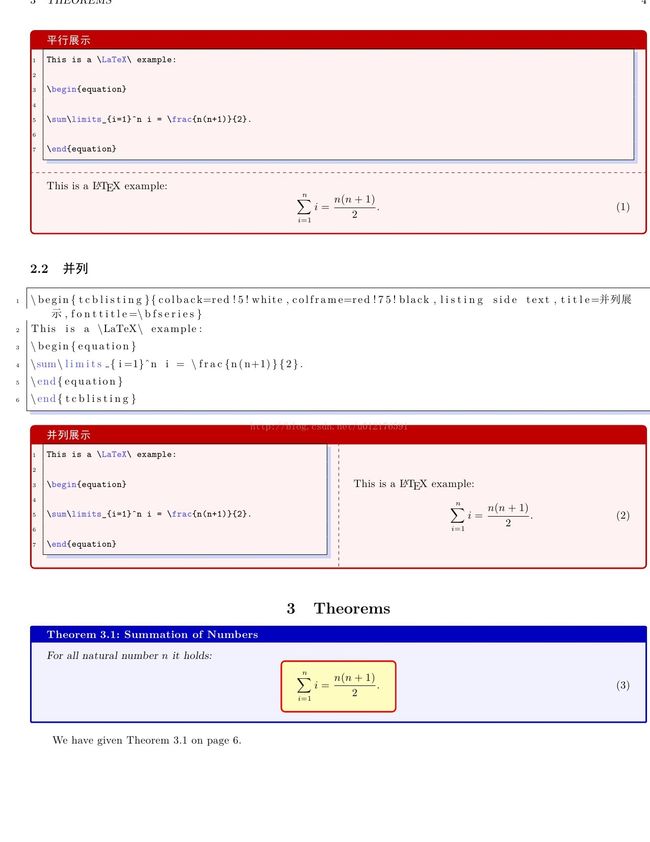latex彩色框
作者:金良(golden1314521@gmail.com) csdn博客:http://blog.csdn.net/u012176591

- http://www.ctan.org/pkg/tcolorbox
- https://mirror.hmc.edu/ctan/macros/latex/contrib/tcolorbox/tcolorbox.pdf
\documentclass{ctexart}
\usepackage{tikz,lipsum,lmodern}
\usepackage[most]{tcolorbox}
\usepackage[top=1cm,bottom=1cm,left=1cm,right=1mm]{geometry}
\usepackage{listings}
\lstset{numbers=left,breaklines,
numberstyle= \tiny,keywordstyle= \color{ blue!70},commentstyle=\color{red!50!green!50!blue!50},
frame=shadowbox, rulesepcolor= \color{ red!20!green!20!blue!20},
escapeinside=``}
\begin{document}
\section{Colored boxes}
\subsection{1}
\begin{lstlisting}[language={TeX}]
\begin{tcolorbox}[colback=red!5!white,colframe=red!75!black]
My box.
\end{tcolorbox}
\end{lstlisting}
\begin{tcolorbox}[colback=red!5!white,colframe=red!75!black]
My box.
\end{tcolorbox}
\subsection{2}
\begin{lstlisting}[language={TeX}]
\begin{tcolorbox}[colback=blue!5!white,colframe=blue!75!black,title=`给框加标题`]
My box with my title.
\end{tcolorbox}
\end{lstlisting}
\begin{tcolorbox}[colback=blue!5!white,colframe=blue!75!black,title=`给框加标题`]
My box with my title.
\end{tcolorbox}
\subsection{3}
\begin{lstlisting}[language={TeX}]
\begin{tcolorbox}[colback=green!5!white,colframe=green!75!black]
Upper part of my box.
\tcblower
Lower part of my box.
\end{tcolorbox}
\end{lstlisting}
\begin{tcolorbox}[colback=green!5!white,colframe=green!75!black]
Upper part of my box.
\tcblower
Lower part of my box.
\end{tcolorbox}
\subsection{4}
\begin{lstlisting}[language={TeX}]
\begin{tcolorbox}[colback=yellow!5!white,colframe=yellow!50!black,
colbacktitle=yellow!75!black,title=My title]
I can do this also with a title.
\tcblower
Lower part of my box.
\end{tcolorbox}
\end{lstlisting}
\begin{tcolorbox}[colback=yellow!5!white,colframe=yellow!50!black,
colbacktitle=yellow!75!black,title=My title]
I can do this also with a title.
\tcblower
Lower part of my box.
\end{tcolorbox}
\subsection{5}
\begin{lstlisting}[language={TeX}]
\begin{tcolorbox}[colback=yellow!10!white,colframe=red!75!black,lowerbox=invisible,
savelowerto=\jobname_ex.tex]
Now, we play hide and seek. Where is the lower part?
\tcblower
I'm invisible until you find me.
\end{tcolorbox}
\end{lstlisting}
\begin{tcolorbox}[colback=yellow!10!white,colframe=red!75!black,lowerbox=invisible,
savelowerto=\jobname_ex.tex]
Now, we play hide and seek. Where is the lower part?
\tcblower
I'm invisible until you find me.
\end{tcolorbox}
\subsection{6}
\begin{lstlisting}[language={TeX}]
\begin{tcolorbox}[colback=yellow!10!white,colframe=red!75!black,title=Here I am]
\input{\jobname_ex.tex}
\end{tcolorbox}
\end{lstlisting}
\begin{tcolorbox}[colback=yellow!10!white,colframe=red!75!black,title=Here I am]
\input{\jobname_ex.tex}
\end{tcolorbox}
\subsection{7}
\begin{lstlisting}[language={TeX}]
\begin{tcolorbox}[enhanced,sharp corners=uphill,
colback=blue!50!white,colframe=blue!25!black,coltext=yellow,
fontupper=\Large\bfseries,arc=6mm,boxrule=2mm,boxsep=5mm,
borderline={0.3mm}{0.3mm}{white}]
Funny settings.
\end{tcolorbox}
\end{lstlisting}
\begin{tcolorbox}[enhanced,sharp corners=uphill,
colback=blue!50!white,colframe=blue!25!black,coltext=yellow,
fontupper=\Large\bfseries,arc=6mm,boxrule=2mm,boxsep=5mm,
borderline={0.3mm}{0.3mm}{white}]
Funny settings.
\end{tcolorbox}
\subsection{8}
\begin{lstlisting}[language={TeX}]
\begin{tcolorbox}[enhanced,frame style image=blueshade.png,
opacityback=0.75,opacitybacktitle=0.25,
colback=blue!5!white,colframe=blue!75!black,
title=My title]
This box is filled with an external image.\par
Title and interior are made partly transparent to show the image.
\end{tcolorbox}
\end{lstlisting}
\begin{tcolorbox}[enhanced,frame style image=blueshade.png,
opacityback=0.75,opacitybacktitle=0.25,
colback=blue!5!white,colframe=blue!75!black,
title=My title]
This box is filled with an external image.\par
Title and interior are made partly transparent to show the image.
\end{tcolorbox}
\subsection{9}
\begin{lstlisting}[language={TeX}]
\begin{tcolorbox}[enhanced,attach boxed title to top center={yshift=-3mm,yshifttext=-1mm},
colback=blue!5!white,colframe=blue!75!black,colbacktitle=red!80!black,
title=`给框加标题`,fonttitle=\bfseries,
boxed title style={size=small,colframe=red!50!black} ]
This box uses a \textit{boxed title}. The box of the title can
be formatted independently from the main box.
\end{tcolorbox}
\end{lstlisting}
\begin{tcolorbox}[enhanced,attach boxed title to top center={yshift=-3mm,yshifttext=-1mm},
colback=blue!5!white,colframe=blue!75!black,colbacktitle=red!80!black,
title=给框加标题,fonttitle=\bfseries,
boxed title style={size=small,colframe=red!50!black} ]
This box uses a \textit{boxed title}. The box of the title can
be formatted independently from the main box.
\end{tcolorbox}
%----------------------------------------------------------
\section{LaTeX代码和显示效果并列展示}
如果把可选参数里的标题相关的选项``title,fonttitle''去掉,会产生没有表题栏的框。
\subsection{平行}
\begin{lstlisting}[language={TeX}]
\begin{tcblisting}{colback=red!5!white,colframe=red!75!black,title=`平行展示`,fonttitle=\bfseries}
This is a \LaTeX\ example:
\begin{equation}
\sum\limits_{i=1}^n i = \frac{n(n+1)}{2}.
\end{equation}
\end{tcblisting}
\end{lstlisting}
\begin{tcblisting}{colback=red!5!white,colframe=red!75!black,title=平行展示,fonttitle=\bfseries}
This is a \LaTeX\ example:
\begin{equation}
\sum\limits_{i=1}^n i = \frac{n(n+1)}{2}.
\end{equation}
\end{tcblisting}
\subsection{并列}
\begin{lstlisting}[language={TeX}]
\begin{tcblisting}{colback=red!5!white,colframe=red!75!black,listing side text,title=`并列展示`,fonttitle=\bfseries}
This is a \LaTeX\ example:
\begin{equation}
\sum\limits_{i=1}^n i = \frac{n(n+1)}{2}.
\end{equation}
\end{tcblisting}
\end{lstlisting}
\begin{tcblisting}{colback=red!5!white,colframe=red!75!black,listing side text,
title=并列展示,fonttitle=\bfseries}
This is a \LaTeX\ example:
\begin{equation}
\sum\limits_{i=1}^n i = \frac{n(n+1)}{2}.
\end{equation}
\end{tcblisting}
%----------------------------------------------------------
\section{Theorems}
\newtcbtheorem[auto counter,number within=section]{theo}%
{Theorem}{fonttitle=\bfseries\upshape, fontupper=\slshape,
arc=0mm, colback=blue!5!white,colframe=blue!75!black}{theorem}
\begin{theo}{Summation of Numbers}{summation}
For all natural number $n$ it holds:
\begin{equation}
\tcbhighmath{\sum\limits_{i=1}^n i = \frac{n(n+1)}{2}.}
\end{equation}
\end{theo}
We have given Theorem \ref{theorem:summation} on page \pageref{theorem:summation}.
\newtcbtheorem[use counter from=theo]{antheo}%
{Theorem}{theorem style=change,oversize,enlarge top by=1mm,enlarge bottom by=1mm,
enhanced jigsaw,interior hidden,fuzzy halo=1mm with green,
fonttitle=\bfseries\upshape,fontupper=\slshape,
colframe=green!75!black,coltitle=green!50!blue!75!black}{antheorem}
\begin{antheo}{Summation of Numbers}{summation}
For all natural number $n$ it holds:
\begin{equation}
\tcbhighmath{\sum\limits_{i=1}^n i = \frac{n(n+1)}{2}.}
\end{equation}
\end{antheo}
%----------------------------------------------------------
\section{加图片水印}
\begin{tcolorbox}[enhanced,watermark graphics=Basilica_5.png,
watermark opacity=0.3,watermark zoom=0.9,
colback=green!5!white,colframe=green!75!black,
fonttitle=\bfseries, title=Box with a watermark picture]
一方面,老师上课比较“即兴”,讲的时候很多东西都是穿插着讲的,并不依循一个特定的逻辑顺序,所以在整理的过程中,就需要充分理解上课所讲的材料,理清它们的关系,然后重新归纳出一个合乎逻辑的顺序。另一方面,由于时间很紧张,很多定理和命题,老师都没有给出证明,这些证明我都在整理笔记的过程中自己独立完成了。回头看来,这个过程其实使自己受到了一个充分的数学训练——相当于把整个体系从头到尾推导了一遍。很多概念,定理,以及它们的关系,在这个过程中被充分消化了。
\end{tcolorbox}
%----------------------------------------------------------
\section{Boxes in boxes}
\begin{tcolorbox}[colback=yellow!10!white,colframe=yellow!50!black,
every box/.style={fonttitle=\bfseries},title=Box]
\begin{tcolorbox}[enhanced,colback=red!10!white,colframe=red!50!black,
colbacktitle=red!85!black,
title=Box inside box,drop fuzzy shadow]
\begin{tcolorbox}[beamer,colframe=blue!50!black,title=Box inside box inside box]
And now for something completely different: Boxes!\par\medskip
\newtcbox{\mybox}[1][]{nobeforeafter,tcbox raise base,colframe=green!50!black,colback=green!10!white,
sharp corners,top=1pt,bottom=1pt,before upper=\strut,#1}
\mybox[rounded corners=west]{This} \mybox{is} \mybox{another} \mybox[rounded corners=east]{box.}
\end{tcolorbox}
\end{tcolorbox}
\end{tcolorbox}
\section{Fit Boxes}
``fit to height''制定框的高度,框里的内容会自动调整到合适的字体大小以适应该高度。
\begin{tcolorbox}[enhanced,fit to height=5cm,
colback=green!25!black!10!white,colframe=green!75!black,title=Fit box (10cm),
drop fuzzy shadow,watermark color=white,watermark text=Fit]
由于老师讲课没有依据特定的教材(这似乎是MIT的风格,我在这上的所有课都没有特定教材的),而且连lecture notes都没有。我的做法是在堂上记下笔记,然后每周都抽出时间把笔记用Latex整理成Notes。事实上,这些整理出来的Notes我在整理完后已经不太需要看了,真正发挥作用的是这个整理的过程,它对于知识的吸收起到了很重要的作用。
一方面,老师上课比较“即兴”,讲的时候很多东西都是穿插着讲的,并不依循一个特定的逻辑顺序,所以在整理的过程中,就需要充分理解上课所讲的材料,理清它们的关系,然后重新归纳出一个合乎逻辑的顺序。另一方面,由于时间很紧张,很多定理和命题,老师都没有给出证明,这些证明我都在整理笔记的过程中自己独立完成了。回头看来,这个过程其实使自己受到了一个充分的数学训练——相当于把整个体系从头到尾推导了一遍。很多概念,定理,以及它们的关系,在这个过程中被充分消化了。
\end{tcolorbox}
\begin{tcolorbox}[enhanced,fit to height=2cm,
colback=green!25!black!10!white,colframe=green!75!black,title=Fit box (5cm),
drop fuzzy shadow,watermark color=white,watermark text=Fit]
由于老师讲课没有依据特定的教材(这似乎是MIT的风格,我在这上的所有课都没有特定教材的),而且连lecture notes都没有。我的做法是在堂上记下笔记,然后每周都抽出时间把笔记用Latex整理成Notes。事实上,这些整理出来的Notes我在整理完后已经不太需要看了,真正发挥作用的是这个整理的过程,它对于知识的吸收起到了很重要的作用。
一方面,老师上课比较“即兴”,讲的时候很多东西都是穿插着讲的,并不依循一个特定的逻辑顺序,所以在整理的过程中,就需要充分理解上课所讲的材料,理清它们的关系,然后重新归纳出一个合乎逻辑的顺序。另一方面,由于时间很紧张,很多定理和命题,老师都没有给出证明,这些证明我都在整理笔记的过程中自己独立完成了。回头看来,这个过程其实使自己受到了一个充分的数学训练——相当于把整个体系从头到尾推导了一遍。很多概念,定理,以及它们的关系,在这个过程中被充分消化了。
\end{tcolorbox}
\section{可断的框}
该框的内容如果在当前页不能完全显示,可以自动顺延到下一页,产生断裂的框。
\begin{tcolorbox}[enhanced jigsaw,breakable,pad at break*=1mm,
colback=blue!5!white,colframe=blue!75!black,title=Breakable box,
watermark color=white,watermark text=\Roman{tcbbreakpart}]
决定选数学作为minor,从这个学期开始会上一系列的数学课。这个学期选的是Real and Functional Analysis,这门课已经进入尾声,下周就要考试了。
这门课主要讲的是测度论和勒贝格积分理论,以及一些基础的泛函分析,这些内容自己以前也自学过,不过经过一个学期的学习,还是觉得有不少新的收获。
由于老师讲课没有依据特定的教材(这似乎是MIT的风格,我在这上的所有课都没有特定教材的),而且连lecture notes都没有。我的做法是在堂上记下笔记,然后每周都抽出时间把笔记用Latex整理成Notes。事实上,这些整理出来的Notes我在整理完后已经不太需要看了,真正发挥作用的是这个整理的过程,它对于知识的吸收起到了很重要的作用。
一方面,老师上课比较“即兴”,讲的时候很多东西都是穿插着讲的,并不依循一个特定的逻辑顺序,所以在整理的过程中,就需要充分理解上课所讲的材料,理清它们的关系,然后重新归纳出一个合乎逻辑的顺序。另一方面,由于时间很紧张,很多定理和命题,老师都没有给出证明,这些证明我都在整理笔记的过程中自己独立完成了。回头看来,这个过程其实使自己受到了一个充分的数学训练——相当于把整个体系从头到尾推导了一遍。很多概念,定理,以及它们的关系,在这个过程中被充分消化了。
\end{tcolorbox}
\end{document}





